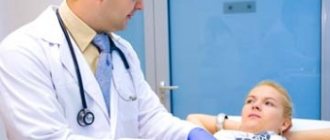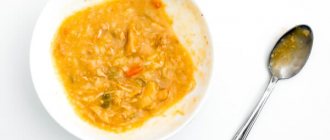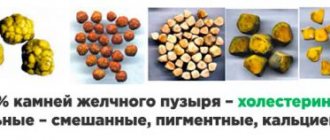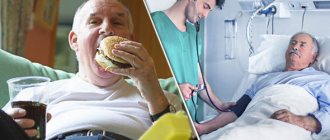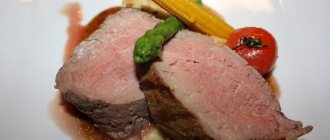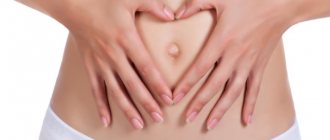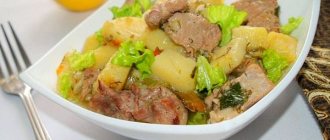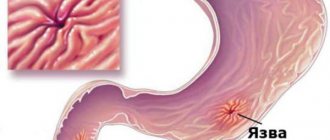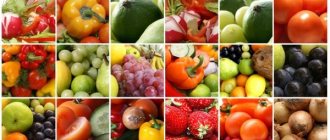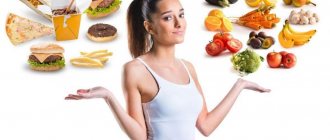Diet is the foundation in the treatment and prevention of gallbladder polyposis. Up to 7% of the world's population suffers from polyposis. Most often, the disease is detected in women over 40 years of age. Proper dietary nutrition can minimize the load on the gallbladder, reduce irritation of the organ and normalize the functioning of the digestive tract. The diet for polyposis is based on therapeutic diet No. 5 according to Pevzner.
Briefly about polyposis
Polyposis is a disease characterized by pathological growths of the mucous membrane of the gallbladder. They grow into the lumen of the organ and can interfere with the passage of bile into the biliary tract. There are 4 types of polyps:
- Cholesterol. Polyps are made up of cholesterol deposits.
- Inflammatory. These are polyps consisting of granulation tissue in inflammatory diseases of the gallbladder.
- Adenomatous. This is a neoplasm consisting of glandular tissue.
- Papillomatous. Such polyps consist of papillary growths.
A polyp is a benign tumor, but it can nevertheless turn into a malignant neoplasm. Polyposis has no clinical picture and is often discovered by chance on ultrasound diagnostics of the abdominal organs, liver or gall bladder.
Methods for removing polyps
It is imperative to remove tumors in order to reduce the possibility of gastric bleeding and strangulation of the polyp. The most dangerous thing is the growth and degeneration of a polyp into a cancerous tumor. If the operation is done on time, the consequences of removal are practically absent. There are three removal methods:
- Abdominal surgery. It is performed for multiple large polyps. It is done under general anesthesia. It takes a lot of time to recover.
- Endoscopic removal of polyps. A common, safe method, despite the complexity of the procedure. Prescribed for single formations of small size.
- Laser removal. A gentle but expensive option. The polyp is cauterized layer by layer using a laser beam. Sealing the blood vessels promotes healing and the absence of scars.
When polyps are removed, the prognosis is favorable. Restoration of working capacity occurs in full. There is a high probability of recurrence. Regular medical examinations allow them to be identified at an early stage and removed.
14 days after the procedure, FGS is performed. It helps the specialist assess the healing process and the presence of complications.
Diet principles
The diet for polyps in the gallbladder consists of the following principles:
- Small but frequent meals. The recommended number of daily meals is from 4 to 6 times. The average weight of one serving for women is 200-250 grams, for men – 250-300 grams.
- You can't overeat. After each meal there should be a slight feeling of hunger. Excessive food consumption puts a strain on the gallbladder and pancreas, leading to dysfunction of these organs.
- The food temperature should be medium (warm). It is not recommended to eat excessively hot or cold food, unless this is provided for by the culinary idea of the dish.
- Fried and smoked foods are limited as much as possible. Fatty foods are limited.
- You should not engage in physical activity for 60-90 minutes after a meal.
- The therapeutic diet excludes coarse fiber foods.
- Minimizing animal fats (30%) and increasing the ratio of vegetable fats (70%).
Basic nutritional recommendations
The menu for polyps should be prescribed by a specialist. Adhering to a certain diet entails a rapid recovery of the patient. According to Pevzner, patients who have had polyps removed from the gallbladder eat diet foods number five. The purpose of this table is to reduce the level of congestion in the digestive system by consuming certain foods and reducing the number of calories.
The patient should adhere to dietary nutrition for at least two months. The duration of the diet may vary depending on the specialist’s prescription and the severity of the consequences.
The number of meals should be increased and the usual portion reduced. The reason for this is the need to reduce the level of load on the organ that secretes bile, stomach, and intestines. Establish frequent meals – at least 5 times a day.
Eating a smaller portion of food should not infringe on the body's needs. A certain amount of proteins and fats. It’s worth ending your diet by gradually switching to regular food. A sharp jump will disrupt the functioning of the digestive system.
Dietary table number five according to Pevzner requires the exclusion of animal and vegetable fats from the normal diet. Replace sugar with glucose of natural origin.
The principles of the diet are the absence of the same menu for every day. The patient should eat a varied, balanced diet. This allows you to lead a normal lifestyle with active brain activity. This will be helped by consuming carbohydrates in the usual amount.
Recommended Products
Gallbladder disease involves changing the diet to improve the patient's condition. To eliminate unpleasant symptoms, a strict diet is proposed that allows a person to feel normal. Foods that have a positive effect on an individual's recovery include:
- Vegetables. As a side dish, beets with carrots, eggplants, broccoli, cauliflower with Brussels sprouts are used. Potatoes are not included in this list due to the starch they contain. This component adversely affects metabolic processes. Carrots with cabbage, peppers with tomatoes and celery are eaten fresh.
- Greenery. It is recommended to include arugula, lettuce, dill with cilantro, parsley and basil in your diet. Salads made from fresh vegetables are an opportunity to get the required amount of vitamins and minerals.
- Milk and dairy products. Cottage cheese with kefir and milk should have a low fat content. Fatty foods burden the digestion process.
- Porridge. Pearl barley and barley, oatmeal and buckwheat are necessary to replenish the body with complex fiber.
- Legumes. These include lentils and beans. Their use has a beneficial effect on the patient’s body, replenishing it with the components necessary for normal life.
- Bread. A representative of this category should not be fresh. A patient who has had a formation in the bile organ removed must take care of himself and avoid food overload. The bread you eat should be chosen from the rye category. Consume white bread the day after purchase.
- Meat fish. Eat meat products and fish from low-fat varieties. Chicken meat, fillet, turkey meat, veal are permitted types of meat. From fish, hake fillet is recommended for patients with polyps.
- Fruits. Consumed fruits replace sweets. After all, the diet does not imply the presence of sweets and confectionery in the diet. Allowed fruits include apricots with peaches, plums with cherries and raspberries, and mangoes with bananas.
Prohibited Products
The disease imposes some restrictions in the form of products. Taking the following types will negatively impact your health and recovery.
- Alcoholic drinks. Drinks containing even a small dose of alcohol negatively affect the patient’s intestinal microflora and the gallbladder, which has to work more intensely.
- Drinks with hops. This includes beer and kvass. Their effect on the intestines is reflected in the organ that produces bile and other organs involved in digestion.
- Carbonated drinks. Carbonated water and sweet carbonated drinks are strictly contraindicated. Alkaline water also falls into this category.
- Coffee, strong tea. Black tea, varieties of coffee. Instantly soluble types such as poppy coffee are especially prohibited.
- Fried foods and foods with high fat content.
- Meat from pork, lamb. The listed types are classified as fatty meats. Treatment of polyps involves following a low-calorie diet.
- Oils, fats. It includes vegetable oil, butter, margarine. It is prohibited to consume butter and margarine-containing products (puff pastry, rich pastries).
- Sweets. Desserts, confectionery and chocolate can pose a threat to a diseased bladder. Processing chocolate is especially difficult for the organ.
- Spices. Restrictions especially apply to spices and salt. Salt intake should be limited to two grams.
- Pickles. Such food is prohibited.
- Pickled foods. The ban on these products is due to the vinegar contained in the marinade.
- Canned food. Regardless of the type of canned food, reduce their consumption to nothing. This also includes preserves and jams.
In addition to the listed products, any other foods that are heavy on the stomach are prohibited. The intestinal mucosa is too sensitive after the disease. Products that cause irritation are excluded from the diet. You should start your meal by drinking a small amount of water.
What foods are included in the diet for gallbladder polyposis?
You can use the following products and dishes:
- biscuits, bread toast, dried bread (preferably yesterday's bread);
- seafood: sea fish without fat, crab and shrimp meat;
- low-fat dairy products, for example, cottage cheese, cheese, milk,
- lean soup, porridge with milk, steamed or stewed vegetable dishes;
- no more than two boiled eggs in 7 days;
- compote, jelly, weak green tea, kefir;
- dried fruits;
- lean meat.
Therapeutic diet after removal
A diet after removal of a polyp in the stomach is prescribed for better restoration of the mucous membrane. You need to follow it for several months. If there are concomitant diseases, the diet is followed for a year.
Consultation with a nutritionist
Dishes are prepared by steaming. Fatty foods are excluded from the diet. Food should be pureed and not contain large pieces.
Authorized products
Acceptable:
- boiled meat;
- oatmeal, pearl barley, slimy decoction of cereals;
- jelly, rosehip infusion;
- low-fat cottage cheese, kefir;
- boiled vegetables;
- herbal teas;
- sprouted wheat sprouts;
- viburnum, pumpkin, garlic, onion.
A diet of permitted foods can be varied and interesting. The main thing is to show imagination when preparing dishes.
Prohibited Products
It is forbidden:
- spices, seasonings;
- smoking, pickling;
- fresh milk;
- coffee, carbonated drinks;
- fresh bread.
During the rehabilitation period, it is worth strictly limiting the consumption of these products. They provoke complications. And you need a healthy lifestyle.
Following proper nutrition after surgery helps to cope with inflammation of the mucous membrane, and this prevents the development of polyps.
In addition to the diet, medications with enzymes are prescribed. They are designed for better absorption of nutrients.
Limited foods and dishes in the gallbladder polyp diet
The following foods and dishes should not be eaten:
- alcohol, coffee and black tea, carbonated sweet drinks;
- fried, smoked, spicy and canned foods;
- White chocolate;
- some vegetables: garlic, onions, eggplants;
- corn, lentil porridge;
- offal, such as lard;
- legumes;
- sour vegetables and berries;
- cakes, baked goods;
- food rich in flavorings.
How to treat a stomach polyp
Experts recommend getting rid of tumors in the stomach using surgical methods: complications should not arise with such treatment. However, evidence that the stomach polyp has resolved due to medication or the use of traditional medicine is also not uncommon. Therefore, before going under the surgeon’s scalpel, it is worth trying all possible methods without resorting to radical measures.
Traditional treatment
Alternative medicine offers many means of combating polyposis. An effective way is to take an infusion of celandine, known for its ability to remove all kinds of papillomas and growths not only on the skin, but also on internal organs. Dried celandine (1 tbsp) pour 250 ml of boiling water, leave for at least an hour. Divide the resulting drink into three parts and take half an hour before meals.
Alcohol tincture of propolis, a popular treatment for diseases of the gastrointestinal tract, will help reduce the polyp of the antrum of the stomach. Heat 90 ml of medical alcohol, add 10 g of propolis, stir until completely dissolved. Take 20–30 drops, after diluting the tincture with water. This recipe should not be used by those who are allergic to honey and other bee products.
An effective means of combating tumors in the stomach is a tincture of walnut septa. Carefully cut them out of 20 fruits, put them in a half-liter jar, and fill them with regular vodka. Closing the lid tightly, place the jar in a dark place for a week, shaking it periodically. Take 2 tbsp. l. such a tincture in the morning half an hour before meals.
Remedies for polyps
Treatment of tumors is inextricably linked with the normalization of the functioning of the entire organ. The drugs “Almagel”, “De-Nol” envelop its walls, “Ranitidine”, “Fasfalugel”, “Motilium” improve its functioning, “Omeprazole”, “Rennie”, “Gastal” have a protective effect, regulate the level of hydrochloric acid, excess which can lead to erosion. The drug "Clarithromycin" stops the proliferation of Helicobacter pylori bacteria, the excessive growth of which often leads to the formation of polyps.
An example of nutrition for gallbladder polyps for one day
Example of a typical diet for one day:
- Breakfast. Options: cottage cheese casserole, oatmeal with milk, rice or banana pudding. You can drink it with weak green tea or compote.
- Lunch. Options: salad of non-acidic vegetables, 1-2 sweet fruits, such as banana or pear.
- Dinner. Options: vegetable soup with vegetable oil, boiled or steamed chicken, rice porridge. You can wash it down with jelly.
- Afternoon snack. 1-2 sweet fruits of your choice. Green tea.
- Dinner. Lean fish, boiled vegetables, mashed potatoes with a piece of butter. You can drink it with weak green tea.
- Before going to bed, you can drink a glass of kefir.
During the day you need to drink an average of 2 liters of mineral water. Borjomi water is recommended: it contains trace elements Na, K, Ca, Mg, Cl, F, silicon, sulfur, boron, titanium, fluorine and electrolytes (bicarbonate, sulfate, iron, aluminum).
When preparing soups, it is recommended to avoid thick broth; it is not recommended to add pepper and other spices; mushroom soups are excluded.
Authorized products
The diet for gallbladder polyposis is based primarily on natural products.
Allowed:
- Carrots, beets, any types of cabbage, zucchini, eggplant. It is recommended to prepare side dishes from them. It is better to avoid potatoes or reduce their consumption to a minimum. Tubers contain starch, which slows down the metabolic process.
- Fresh tomatoes, avocados, peppers, celery.
- Lettuce and any greens.
- Chicken eggs. It is advisable to eat only protein, but once a week you can allow yourself a whole boiled egg or make a steamed omelet from it.
- Non-fat kefir and cottage cheese.
- Non-fatty meats and fish.
- Bread (rye or wheat), but only yesterday’s baking. Fresh bread cannot be eaten.
- Dried fruits.
- Cereal porridges (buckwheat, wheat, pearl barley, oatmeal) cooked in water or low-fat milk.
- Berries and fruits are not sour varieties. It is advisable to replace sweets with them. You can also make jelly, compotes and fruit drinks from the berries.
- Vegetable oils. Their quantity should not exceed 2 tablespoons per day.
- Honey, jelly, natural marmalade and marshmallows.
- Spices you can use are cloves, thyme, cinnamon and bay leaf.
If polyps in the gallbladder lead to discomfort and pain, the food is boiled and crushed (possibly to a puree).
While eating, it is important to chew your food thoroughly. Large pieces in the digestive tract load it, provoking active production of bile.
